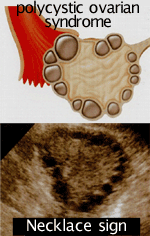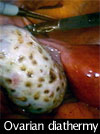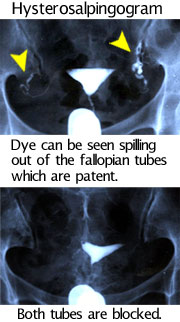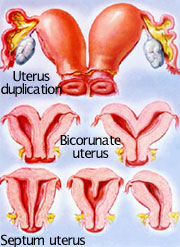
First Visit
– Male fertility test1
Medical Interview
 You will be asked the details of your menstrual cycle such as: menstrual volume, menstrual pain, or pain during intercourse. If you bring a your temperature information with you we will check it.
You will be asked the details of your menstrual cycle such as: menstrual volume, menstrual pain, or pain during intercourse. If you bring a your temperature information with you we will check it.
(E.g. See if you are biphase or not.)
Physical Exam (Transvaginal Ultrasound)
 After your interview you will be examined using transvaginal ultrasound. This procedure is painless.and you can watch the monitor while the doctor explains in detail what you are looking at. Transvaginal ultrasound is a more modern and accurate method of checking the state of the female reproductive system than transabdominal ultra sound. It can be used to estimate how many ovarian follicles would develop by use of an ovulation-inducing agent. As the name suggests, a probe is passed through the vagina to look at the: uterus size and condition (irregularities such as endometriosis or uterine myoma); endometrial shape, position, and thickness; development of ovarian antral follicles (immature eggs), and their development; prevention of OHSS (ovarian hyperstimulation syndrome) which sometimes occurs when more follicles than desired are caused to develop as a side effect of the ovulation inducing agent.
After your interview you will be examined using transvaginal ultrasound. This procedure is painless.and you can watch the monitor while the doctor explains in detail what you are looking at. Transvaginal ultrasound is a more modern and accurate method of checking the state of the female reproductive system than transabdominal ultra sound. It can be used to estimate how many ovarian follicles would develop by use of an ovulation-inducing agent. As the name suggests, a probe is passed through the vagina to look at the: uterus size and condition (irregularities such as endometriosis or uterine myoma); endometrial shape, position, and thickness; development of ovarian antral follicles (immature eggs), and their development; prevention of OHSS (ovarian hyperstimulation syndrome) which sometimes occurs when more follicles than desired are caused to develop as a side effect of the ovulation inducing agent.
Hormone Tests (Blood Tests)
 In many cases an irregular period indicates an ovulation disorder. Existence of ovulation disorder can be recognized through the use of transvaginal ultrasound. If any suspicions exist, we will do a blood test called LH-RH test that is a hormone test to determine if the origin of the problem is due to the pituitary gland, hypothalamus, or ovary. Also we would perform a TRH test to check the level of prolactin (hormone that leads to the production of breast milk), since when the level of Prolactin is high it can causes an ovulation or implantation disorder. These 2 tests allow us to know where and what degree the problems might be.
In many cases an irregular period indicates an ovulation disorder. Existence of ovulation disorder can be recognized through the use of transvaginal ultrasound. If any suspicions exist, we will do a blood test called LH-RH test that is a hormone test to determine if the origin of the problem is due to the pituitary gland, hypothalamus, or ovary. Also we would perform a TRH test to check the level of prolactin (hormone that leads to the production of breast milk), since when the level of Prolactin is high it can causes an ovulation or implantation disorder. These 2 tests allow us to know where and what degree the problems might be.
The most common case of ovulation disorder is Polycystic Ovarian Syndrome (PCOS). A very high level of LH (luteinizing hormone) is suggestive of PCOS and these tests can easily detect it. The golf ball dimples indicate where diathermy had been carried out in the below image.
Polycystic Ovarian Syndrome (PCOS) 
- Multiple small cysts and increased tissue between the cysts (necklace sign).
- A menstrual disturbance – usually oligomenorrhoe, sometimes amenorrhoe.
- The symptoms of too much testosterone – acne, greasy skin and unwanted hair.
- Obesity
Hysterosalpingogram


A Hysterosalpinogram is more accurate than both kimographic uterotubal insufflation and hydrotubation methods. It is essentially an x-ray procedure in which a radio-opaque dye is injected through the cervix into the uterus and fallopian tubes. If the fallopian tubes are normal, you can see the radio-opaque dye pass through the fallopian tubes to the abdominal cavity. It allows the doctor to see if there are any abnormalities, such as an unusually shaped uterus, tumors, or blockages of the fallopian tubes. Examples of unusually shaped uteri detected by this test are having uterus separation/duplication (having 2 uteri), sepum uterus (having a wall across the center of the uterus), and a bicornuate uterus (the uterus has two horns and a heart shape). A blockage in the fallopian tubes or narrowing of the fallopian tubes can also be seen but outside adhesion of the tubes cannot. If a blockage in a fallopian tube were found, a second hysterosalpinogram would be required to confirm if a problem such as Salpingemphraxis exists. Sometimes when a woman is fearful of the procedure her reaction may lead to a constriction of the fallopian tubes, which would lead to a false result (would show a blockage when there actually was none). If it is felt that this is the case we will reexamine you another day. Please remember that you require an appointment for this test.
Note:
The image by some is that a hysterosalpinogram is a painful procedure. It is true that in case where a woman has a blockage she may have intense pain and in these cases bed rest may be required until the pain subsides. The majority of women tested do not have blockages, do not experience such pain, and are finished in 1-2 minutes. If you are preoccupied with the fear of pain you could subconsciously cause your fallopian tubes to constrict which would in turn cause more discomfort. Please tell us if you would prefer to be given some pain medication.
